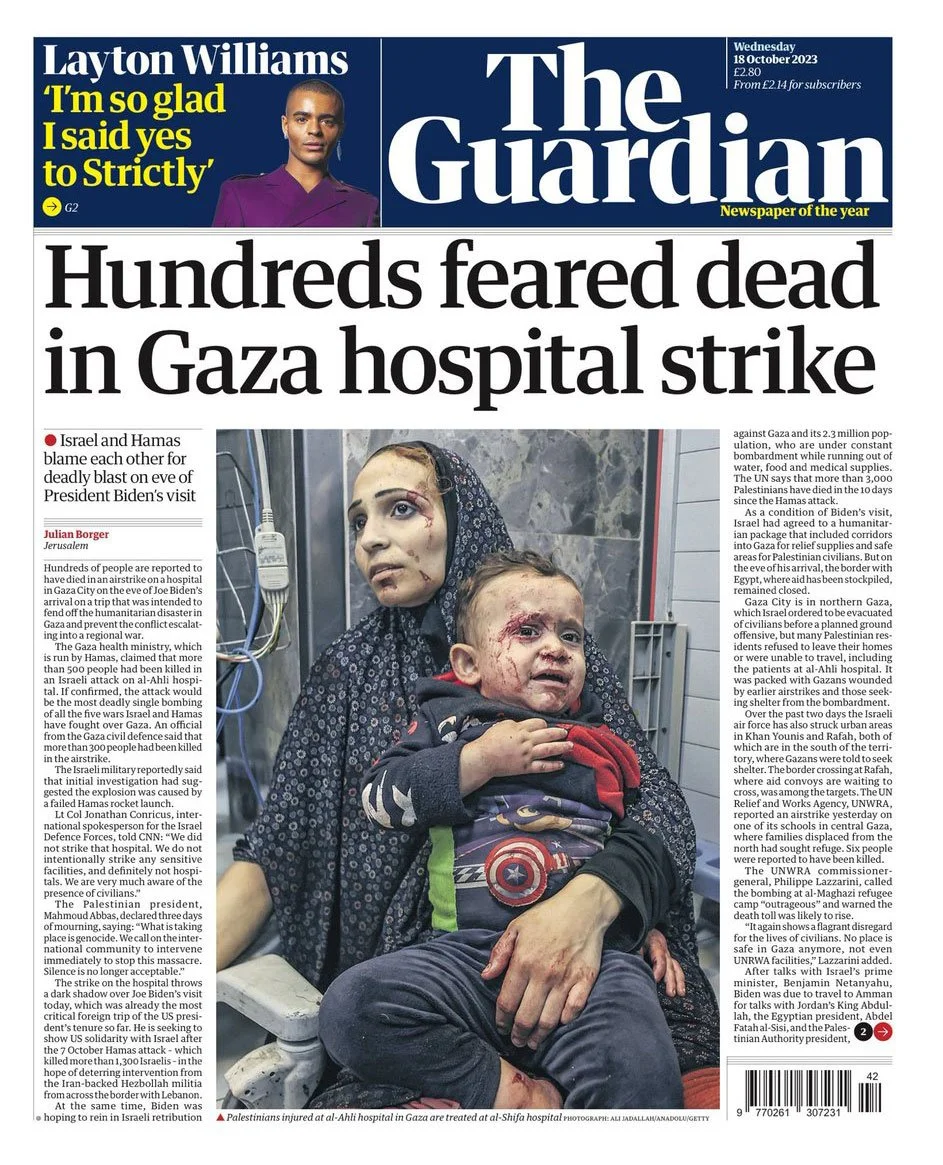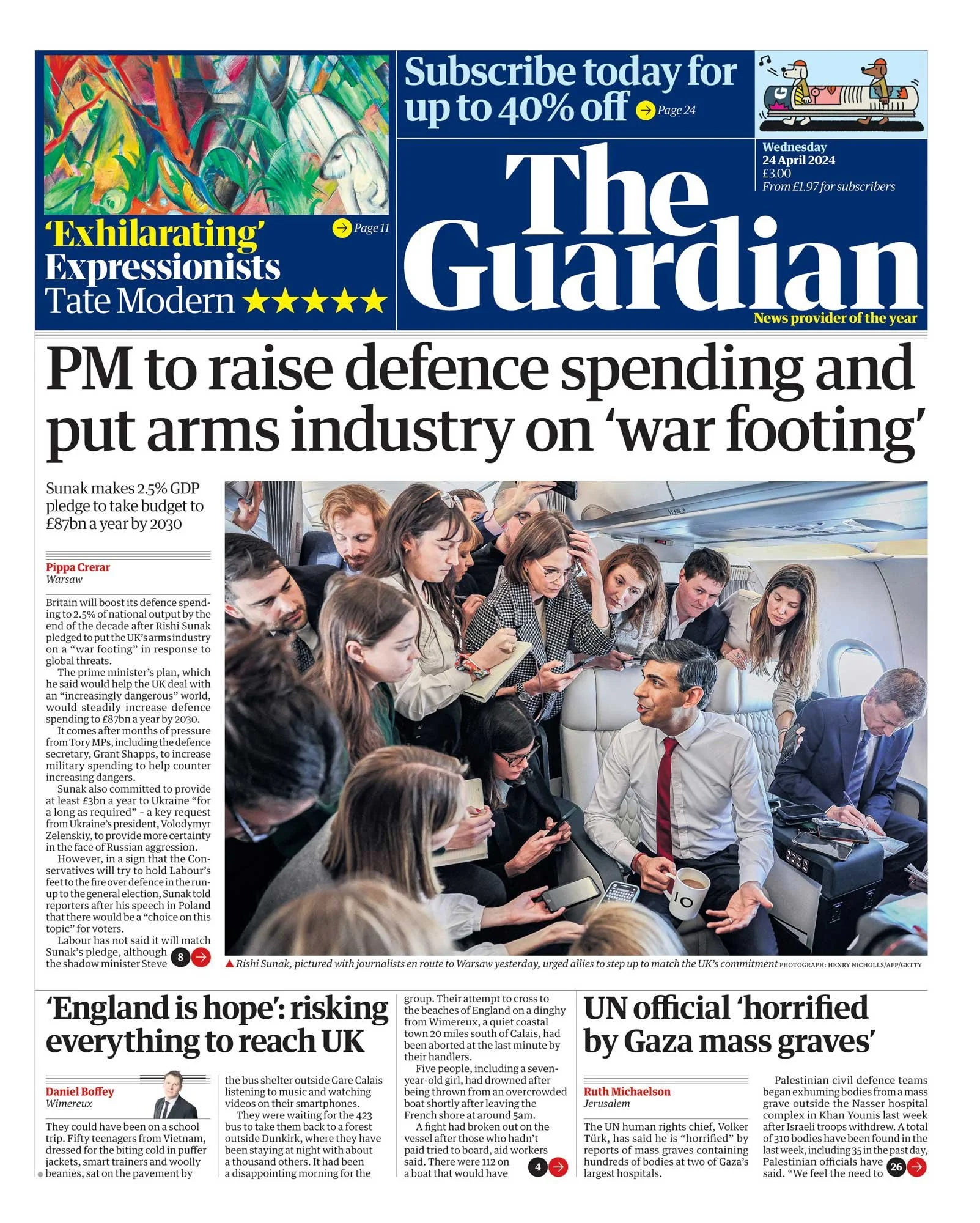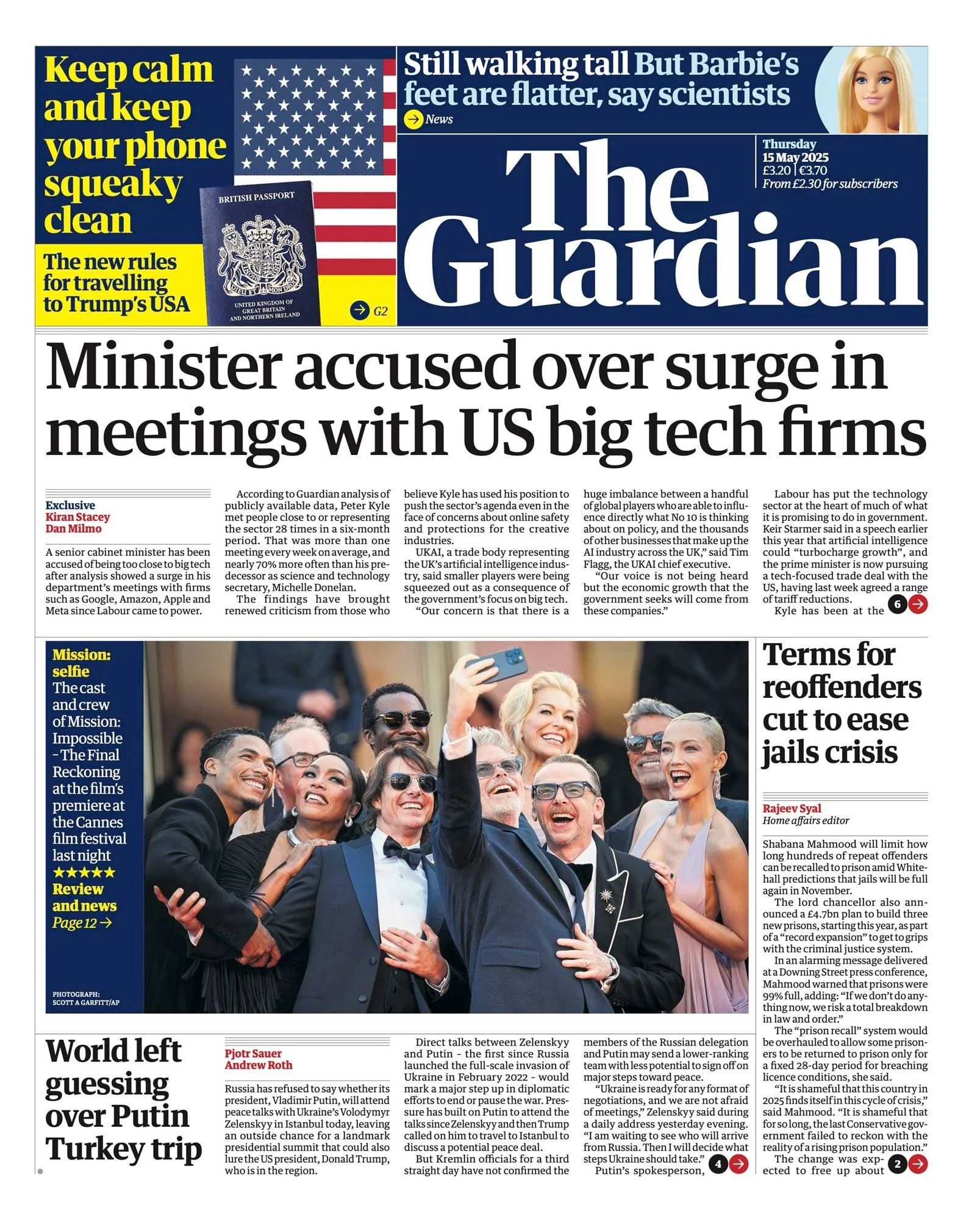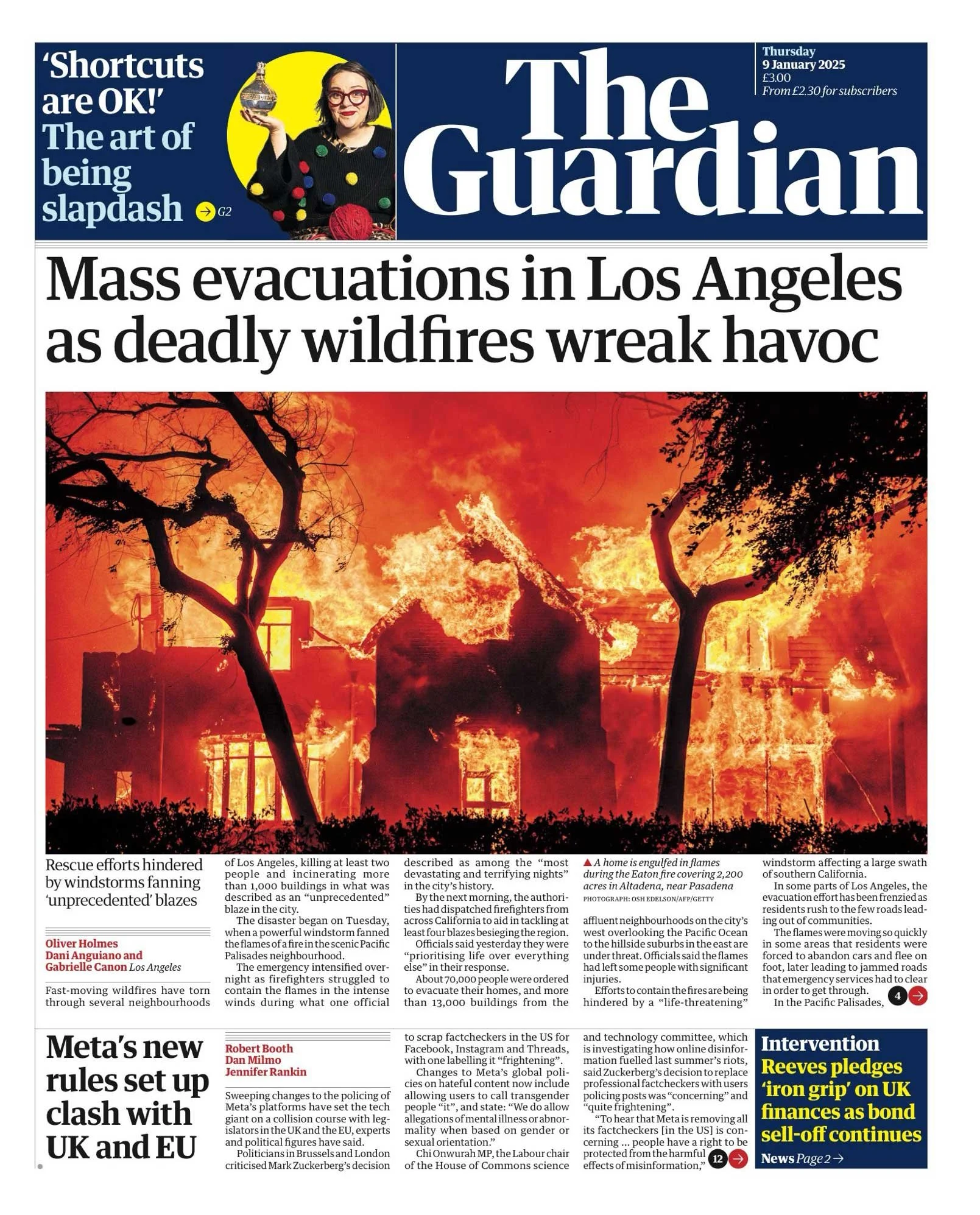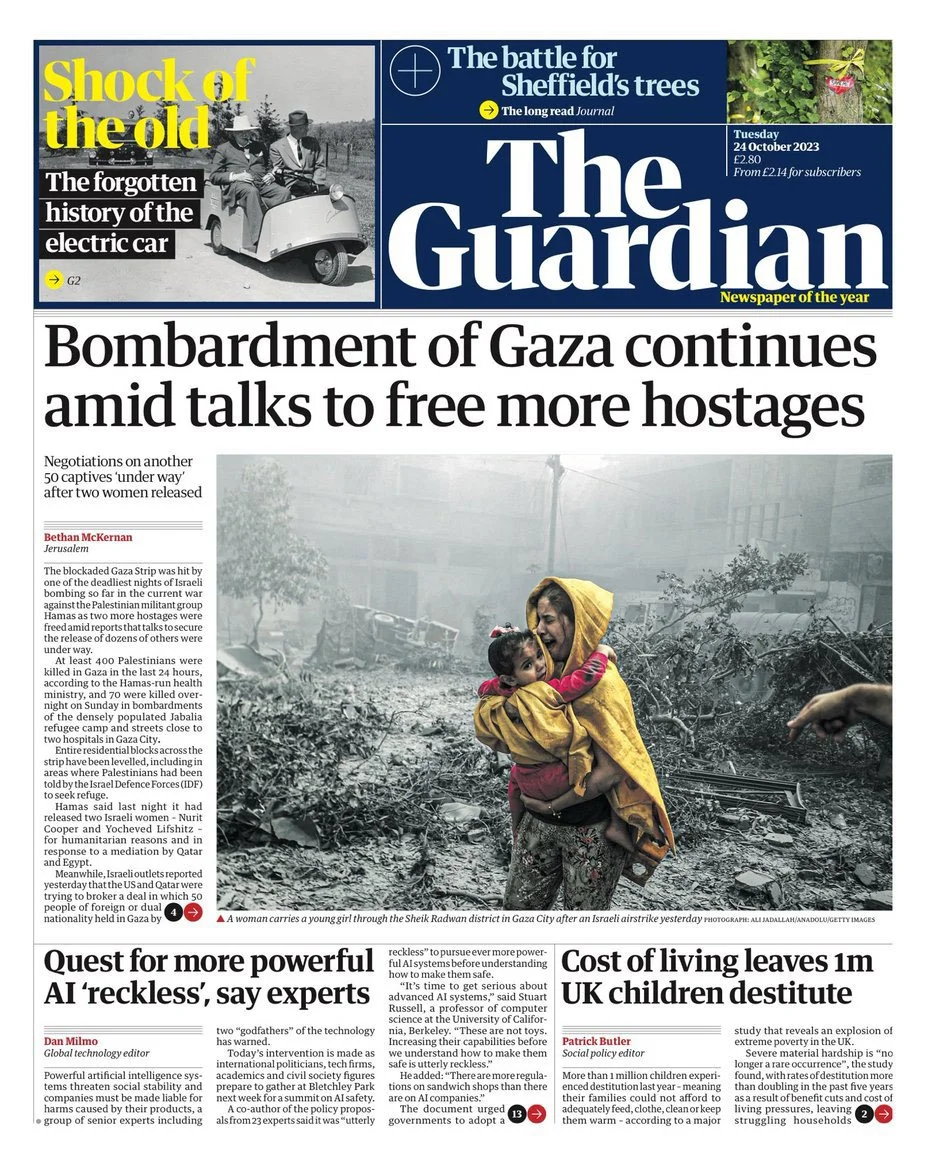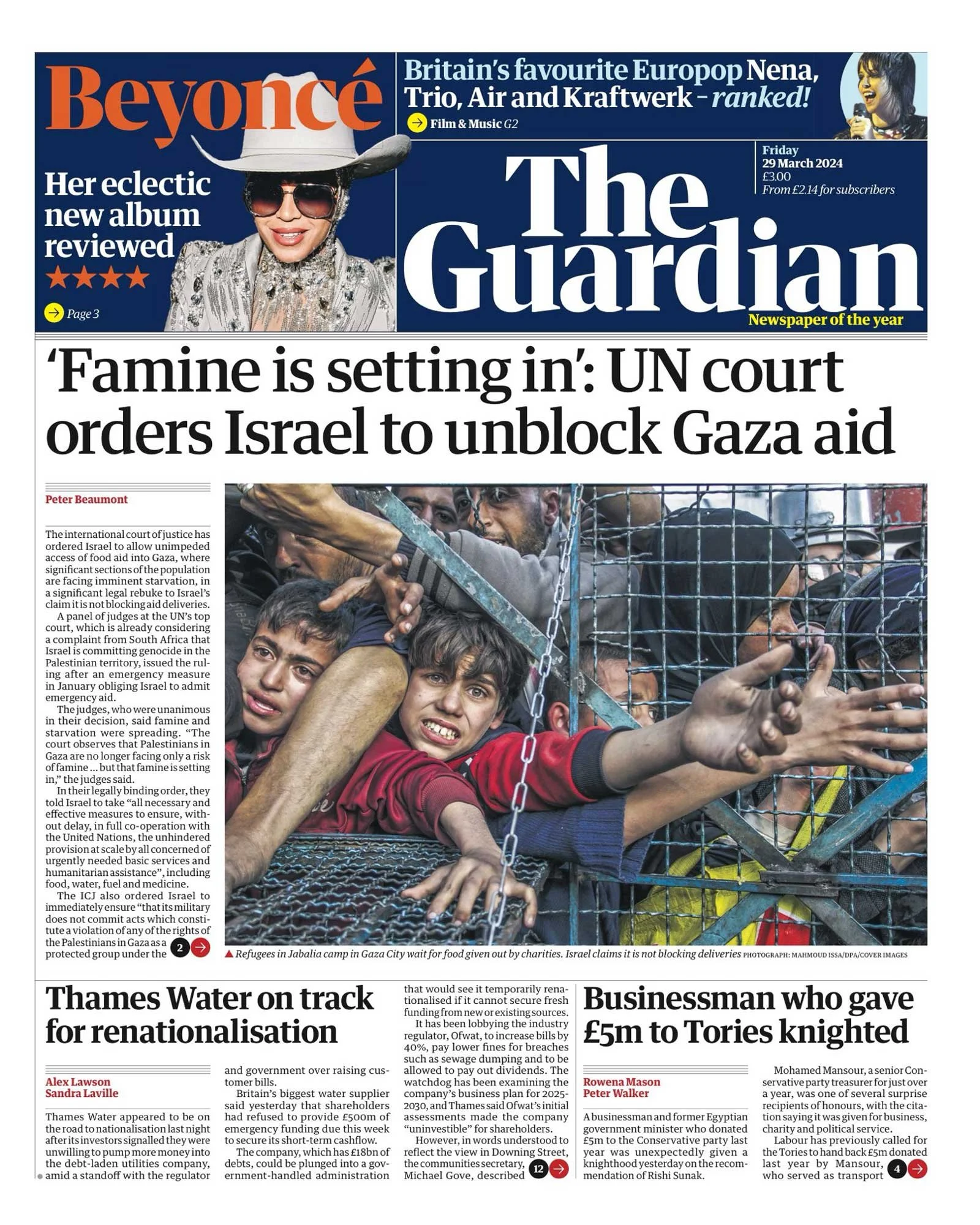In Conversation with Finbarr O’Reilly
HM: Fiona, I’m sure nobody grows up as a child thinking, “One day, I’m going to be the Head of Photography at The Guardian.”
FO’R: (Laughs) Absolutely not! That definitely wasn’t on my radar when I was young. In fact, nobody in my family had any connection to journalism or photography. So, when I announced as a teenager that I wanted to study journalism, it came as a huge surprise to them.
The spark actually came from my English teacher. She really encouraged me and planted the idea that journalism could be a path worth exploring. That idea just stuck with me. By the time I finished school, I felt compelled to give it a try, so I applied to study journalism at the London College of Printing—now known as the London College of Communication.
When I was 18, I packed my bags, left home, and moved to London. It was an exciting but intimidating leap. At the time, I assumed I would become a writer, probably a feature writer of some kind. But as I went through the course, I began to realize that my writing, while solid, didn’t have the unique spark or originality that some of my peers had. That was a bit of a crisis moment for me because I’d pinned so much on that dream.
HM: That must have been difficult—to realize your original plan might not be the right fit.
FO’R: It was, yes. But it also pushed me to explore other avenues. Towards the end of the course, I got an opportunity to work at a current affairs magazine as an editorial assistant. That role was transformative.
I was doing a bit of everything—writing, editing, layout, design—and I discovered that what really lit me up was the visual side of storytelling. I realized I was much more passionate, and frankly better, at communicating ideas through images rather than words.
That was the moment I pivoted. I took all the principles I’d learned about reporting and applied them to visual journalism. It felt like coming home. Looking back, it was the best decision I could have made.
Now, when I talk to students—or even my own kids—I always say: pay attention to where your true strengths lie. You might have an idea of what you want to do, but if it doesn’t align with your natural talents, you’ll end up frustrated. Sometimes the smartest thing you can do is change direction and lean into the thing you’re genuinely good at. That’s where you’ll thrive.
HM: You know, I went to the London College of Printing too!
FO’R: Really? I had no idea! That’s amazing.
HM: Yes—way back in 1966.
FO’R: Wow, that’s incredible! I was there in the late 80s, so we were definitely in very different eras. I can only imagine what it must have been like in the 60s. What did you study?
HM: Photography and design. It was a completely new experience for me, and the college itself was brand-new at the time. I’d just moved to the UK in the 60s and it was quite an adventure. Everything felt new and exciting—the city, the culture, the college. It really opened up my world.
FO’R: I can relate to that. Even though I came later, in the 80s, London felt like such a vibrant, challenging place. There was a lot of social and political unrest at the time, and being in that environment was eye-opening for me.
I grew up in a fairly conservative setting in Edinburgh, so suddenly being surrounded by people who were questioning authority, fighting for justice, and expressing themselves creatively—it was electrifying. The college was full of that energy, and it was a place where curiosity and boldness were encouraged.
HM: Exactly! For me, arriving in London was like stepping into another universe. I came a couple of months before classes started, and I just wandered the city on foot. I visited every museum, every gallery—soaking it all in. It was overwhelming and inspiring at the same time.
FO’R: Yes, that sounds so familiar! Being in London gave me so many opportunities to explore culture. For instance, the Imperial War Museum was right next to the college, and we were often sent there for assignments.
HM: Really? That’s interesting—I don’t actually remember going there during my time.
FO’R: Oh, we went constantly! I did a lot of writing about exhibitions there. It really helped me develop my analytical skills, even though I eventually moved away from writing.
HM: In my first year, one of the big projects was a competition to design the cover of the college’s official type book. Typography and printing were huge parts of the program back then. I ended up winning that competition!
I can still remember the feeling—here I was, this young kid from another country, and I’d achieved something that made me feel like I truly belonged. That moment gave me such a boost of confidence. In a way, it was one of the reasons I decided to pursue this path seriously.
FO’R: That’s a wonderful story. It’s incredible how those early experiences can shape our lives.
HM: Yes, absolutely.
FO’R: I also loved how practical the college was. It wasn’t just theory—we were drilled in the skills we needed to step straight into the professional world. I sometimes feel like that’s missing from some modern courses, where there’s a lot of conceptual discussion but not enough hands-on training.
Back then, we were learning by doing, which prepared us for the realities of working in journalism, design, or photography. That foundation has stayed with me throughout my entire career.
HM: Let’s talk about influences. When you look back, who or what shaped your perspective on photography? Was there a person, a moment, or an experience that really influenced the direction of your career?
FO’R: I think there were a few key moments, although at the time I didn’t always recognize how important they were.
When I was at college, we were given an assignment to interview someone who had reached the very top of their field. I decided to interview Tim Page, the legendary Vietnam War photographer.
I went to his home and spent an entire afternoon talking with him about his work and his experiences. It was completely fascinating. Tim had this incredible energy—almost like a rock star in the world of photojournalism. He was a bit of a maverick, full of incredible stories, and completely unafraid to take risks.
Now, interestingly, that meeting didn’t make me want to become a photographer myself. But it did completely expand my thinking about the role of photography in journalism and how powerful images can be in shaping our understanding of the world.
That same period was also when The Independent newspaper first launched. I still remember buying the very first issue, almost by accident—I needed change for the bus to get to college! But when I opened it, I was stunned.
The Independent was revolutionary for its time. It gave its photographers remarkable creative freedom. They printed their own images in the darkroom, had influence over layout and design, and were treated as integral voices in the storytelling process. That really struck me.
Later, when I worked at a few different newspapers and eventually arrived at The Guardian, what excited me most was that it shared that same philosophy. At The Guardian, photography was not an afterthought; it was central to how stories were told. My first picture editor there was Eamonn McCabe, who I consider one of the godfathers of British photojournalism. Working with him was an extraordinary privilege and shaped so much of how I approach my work today.
HM: That’s amazing. It’s funny how those encounters can change the entire direction of your life.
When I was young, I had a similar experience. I met Philip Jones Griffiths, the great Welsh photojournalist. He was in Israel at the time, working with Dayan’s daughter, who was producing some projects. I was just starting out, working for an Irish newspaper, and somehow ended up helping him travel around the country for a week.
That one week completely changed my life. Philip was wild, full of energy and ideas. By the end of it, he was the one who pushed me to go to England to study photography. Without him, I might never have taken that step.
FO’R: Wow—that’s extraordinary. And it all came from just one week together?
HM: Exactly. It’s incredible how sometimes you meet someone, and they leave a permanent mark on you. It wasn’t just his advice, either.
Philip also connected me to two remarkable women—his agents, one based in London and the other in Rome. They were both Italian, and they played a huge role in helping me get started in Europe.
Not long after meeting them, I got my first big assignment: photographing a couple traveling across Europe with an El Al bag for a major advertising campaign for the airline. That job was my first time traveling across Europe, and it gave me both the experience and the connections I needed.
When I finally moved to London, those two women kept giving me assignments. It was unbelievable. I didn’t have much money back then, and their support allowed me to survive and grow as a photographer. Looking back, it’s astonishing how one chance meeting can open so many doors.
FO’R: That’s remarkable—and so true. These encounters can shape the entire trajectory of our lives.
I often tell students that you never know when you’ll meet someone who ignites that spark in you. When you’re young, inspiration is like oxygen—you need it to keep going. The right person at the right moment can completely shift your direction, give you courage, or simply make you believe in what’s possible.
And honestly, it doesn’t stop there. Even now, I try to keep learning from every conversation I have. That’s why I love doing interviews like this. It’s not just about sharing my story—I always come away having learned something new myself.
We should never stop educating ourselves or opening our minds to new experiences. It’s what keeps our work alive and evolving.
HM: Speaking of remarkable people, do you know Donna Ferrato?
FO’R: I know of her, yes—the American photographer, right?
HM: Yes, she actually married Philip Jones Griffiths, and they had a daughter together. Their daughter now runs his foundation. Imagine those two under one roof—the energy must have been unbelievable!
FO’R: Absolutely! Two creative forces like that in the same family—what a dynamic legacy to carry forward.
I’ve been very fortunate in my own journey, too. When I arrived at The Guardian, I felt immediately that it was my spiritual home. The leadership there has always respected the role of photography and supported the picture editors.
That respect allowed us to experiment and grow, to really think deeply about how we present stories visually. It’s a rare environment, and I’m deeply grateful for it.
HM: How long have you been with The Guardian now?
FO’R: I started when my son was just a year old—he’s now 28. So, 27 years! It’s hard to believe. Out of all the newspapers I’ve worked for, The Guardian is the place where my values align perfectly with the work we do. It’s been a truly fulfilling part of my life.
HM: That’s a rare thing, to find a place where you truly belong.
FO’R: It really is. I know how lucky I am to have found that kind of home.
HM: So, 27 years is a long time. The media landscape has changed dramatically in that period. What’s been the biggest shift for you?
FO’R: Oh, it’s completely transformed. When I first started, we were purely a print newspaper aimed primarily at a British audience. Yes, we covered international stories, but always with the perspective of speaking to readers in the UK.
Now, it’s a completely different world. Today, The Guardian’s website is visited by around 12 million people every single day, from every corner of the globe. That scale brings enormous opportunities—and enormous responsibility.
We now have major offices in New York and Sydney, in addition to our London headquarters. This allows us to run our journalism in a continuous 24/7 cycle, passing stories seamlessly from one team to another as the world turns.
The way we present photography has also evolved. In print, a single image on the front page carried incredible weight. Online, there’s no single “front page.” Instead, we think about how images work across a variety of contexts—mobile, social media, long-form features, and breaking news. The storytelling is more fluid now, and so are the visual demands.
HM: That’s extraordinary. And of course, now you’re dealing with a staggering number of images every day. How do you even begin to manage that?
FO’R: It is staggering! We now receive over 30,000 images a day.
To put that into perspective, during 9/11—the biggest news day of my early career—we received about 2,000 images in a 24-hour period. At the time, that felt overwhelming. Now, 2,000 images would barely register!
Our team uses a highly organized system with keyword tagging, so we can quickly search for images related to specific stories or themes. Everyone across The Guardian, whether they’re in London, New York, or Sydney, can access this system.
One challenge, though, is the sheer emotional weight of it. A picture researcher looking for an image for a travel story might unexpectedly stumble across graphic photos from a conflict zone. To protect our team, we’ve built tools into the system that flag sensitive content, so people aren’t blindsided by disturbing images.
HM: With 30,000 images coming in, how do you decide which ones to publish? That seems like an almost impossible task.
FO’R: It can feel that way, but our team has incredibly sharp instincts.
Every morning, we start by reviewing the day’s major stories so we know what we’re looking for. Then we comb through the submissions, carefully and methodically. Our goal isn’t just to find the “best” picture, but the one that connects.
It’s fascinating—picture editors around the world often land on the same image, even without communicating. That tells you there’s some universal quality, some magic ingredient that makes a photograph resonate.
For me, it’s very instinctive. If a photo moves me, challenges me, or makes me stop in my tracks, I know it has power. That’s the image I’ll show my editor. Photography is about emotion as much as information.
HM: When I was at Visa Pour l’Image, I had lunch with three photographers. One of them was visibly upset. I asked him why, and he told me that he had sent a set of images to a newspaper, complete with carefully written captions. But when the images were published, the captions had been completely changed—altering the entire meaning of the photographs. He felt the publication had distorted the story he was trying to tell.
It really struck me how deeply this affected him.
So my question is: How do you, as a picture editor, balance accuracy with aesthetics and emotional impact? There are so many competing forces—how an image looks, what it means, and what story it tells. How do you navigate that?
FO’R: That’s such an important question. What you’ve described happens more often than people realize, and I completely understand why he was so upset. A single misleading caption can completely alter the interpretation of an image, even when the photo itself hasn’t changed.
At The Guardian, our priority is to maintain both accuracy and integrity. What you see in an image is never the whole truth of a situation—it’s one moment, one perspective. That’s why we rely so heavily on our photographers and our reporters to guide us with context.
For me, this relationship is absolutely essential. I need to be able to trust the photographer to explain what happened before, during, and after that frame was taken. Without that trust, there’s a real danger of misrepresenting someone or distorting a story.
And this is especially crucial now, as we move into the age of AI-generated imagery. The visual world is becoming harder to verify. It’s no longer enough to simply look at a photograph and assume it’s true. So those human relationships—the conversations with photographers and agencies—are more important than ever. They provide the grounding we need to avoid unintentional harm.
HM: Yes, exactly. I was surprised, even shocked, by how deeply the photographer felt betrayed. His work was essentially taken away from him and given a new meaning.
FO’R: I’m not surprised at all. And I think this pressure has increased in today’s media landscape. On social media, people expect to understand a story in a single glance. There’s this constant push for immediacy—images that grab attention in a split second.
That can lead to sensationalism, which is dangerous. Sometimes the most dramatic image isn’t the most accurate one. So as editors, we have to pause and ask ourselves: What is the real impact of this image? Are we communicating the truth, or are we distorting it for effect?
It’s a fine balance. Our job is to make sure the emotional weight of a photograph enhances the truth of a story—not replaces it.
HM: That leads perfectly into my next question. Imagine you have 30,000 images to choose from, and you need to pick one for the front page. What’s your process? How do you decide which single image will carry the weight of the story?
FO’R: First, I consider how and where the image will appear. A front-page photograph needs to work very differently from one used in a feature or on social media.
For print, the image has to have immediate visual impact. It’s often large and has to stand on its own. But for digital, the priorities change—80% of our online traffic now comes from mobile phones. That means most people will only see the image at a tiny size, often next to just a headline.
So I’m always asking: How will this image read on a small screen? Will it still be powerful and clear when reduced? Because for many readers, that’s their entire first impression of a story.
After that, I verify two things:
1. Source and permissions. We need to know where the image came from and that we have the right to publish it.
2. Authenticity. If there’s any doubt, we put it through a verification process to confirm it’s genuine and accurately represents the event.
Then comes the instinctive part—the editor’s eye. I look for energy in the image. By energy, I mean something alive: movement, humanity, emotion. A great image should have an invisible thread that pulls the viewer in and makes them feel something.
And yes, aesthetics matter too. Composition, color, geometry—these aren’t just artistic choices. They help the viewer understand what they’re looking at. A perfectly composed image can clarify a chaotic scene, while a poor composition can confuse or alienate the viewer.
So the final question I always ask myself is: Does this single frame tell the story truthfully and powerfully, in a heartbeat?
HM: I’ve always wondered about the relationship between photographers and picture editors. Do you think photographers understand how important that relationship is?
FO’R: Not always. And I wish there were more time to build those connections.
In today’s fast-paced newsrooms, it’s nearly impossible to have a close relationship with every photographer we work with. That distance can be unhelpful because it creates room for misunderstanding.
An experienced picture editor should be someone a photographer can trust. But here’s something that often surprises photographers: they are not always the best editors of their own work.
HM: (Laughing) I’ve seen that so many times—it’s unbelievable!
FO’R: Exactly! Photographers are deeply invested in their stories. They remember the adrenaline of the moment, the danger, the difficulty of getting a particular shot. And naturally, those experiences affect how they view their images.
But the viewer doesn’t know any of that backstory. They just see the final photograph. So a photographer might choose an image that’s meaningful to them, but not necessarily the most powerful or communicative for the audience.
That’s where we, as picture editors, come in. I see myself as the interpreter between the photographer, the written story, and the reader. My role is to bridge that gap and select images that best connect with the audience.
HM: I made the mistake once of asking a very famous photographer—someone world-renowned—to choose an image for an interview we were publishing.
When I saw his choice, I was horrified. Truly horrified.
When I asked him why he picked that particular image, he said, “Because I remember how hard it was to take.”
And I told him, “No one looking at this photo can see that struggle. They only see what’s in front of them.”
FO’R: (Laughing) That’s exactly the problem! It happens all the time.
It’s one of the hardest things for photographers to accept. Their personal connection to the story is so strong that it clouds their judgement. This is why having an external editor—or at least another trusted pair of eyes—is absolutely essential.
HM: Do you have advice for photographers who are trying to edit their own work, especially when submitting to competitions or pitching to editors?
FO’R: Yes, definitely.
First, never edit alone. Always ask someone you trust to look at your selection. A fresh perspective is invaluable.
Second, quality over quantity. If a competition asks for 6–12 images, don’t submit 12 unless every single one is strong. One weak image can undermine the entire series.
Third, believe in your work. If there’s even one photo you feel unsure about, leave it out. Judges and editors can sense hesitation.
Finally, make it easy for editors to view your pitch. Don’t send downloads or external links. Instead, create a simple PDF with your images, headline, and brief text. Remember, I receive about 250 emails a day. If your pitch isn’t clear at a glance, it will get lost.
The best pitches are concise, visually strong, and respectful of the editor’s time.
HM: That’s incredibly practical advice. It’s also a reminder that photography isn’t just about taking the image—it’s about communication at every stage, from the photographer’s eye to the viewer’s heart.
FO’R: Exactly. And at its best, it’s a collaboration—a shared commitment to telling the truth with both power and humanity.
HM: Let’s start with something simple but essential. You’ve often spoken to young photographers about the way they present their work. What’s the one piece of advice you keep repeating?
FO’R: It’s such basic advice, but it’s absolutely critical: make it easy for people to see your best work quickly.
I’ve said this so many times over the years—on panels, in mentorships, even in little YouTube clips—and yet, I still get these massive Dropbox folders with seventy-five or more images dumped inside. And I just think, please don’t do that.
Photographers don’t always realize that editors are inundated with material. Imagine thousands of images landing in your inbox every week. It’s overwhelming. When you send an endless folder, you’re asking the editor to do all the work of finding the gems. That’s not realistic.
Instead, curate tightly. Present a handful of strong, cohesive images that tell a clear story. If you make it easy for a busy editor to see, at a glance, why your work matters, you’re already halfway to success.
HM: That’s great advice—and harder to follow than it sounds. Let’s talk about the big picture. The industry is changing fast. Where do you see the future of photography, especially photojournalism, heading? Would you encourage young people to become photographers today?
FO’R: That’s a really good question. Luckily, none of my own kids wanted to become photographers!
Honestly, I would be concerned for anyone entering the field unless they were deeply driven, adaptable, and willing to evolve constantly.
We’re living through a seismic shift with the rise of artificial intelligence. In the past, I would advise young photographers to diversify: don’t rely solely on editorial work, consider commercial work as well, because it generally pays better.
But now, even that commercial work is at risk. A creative director can simply type: "Show me a boy looking out over a sunset on a Greek island"—and within seconds, an AI can generate the image. No travel, no photographer required. That’s a reality we have to confront.
This means agility is essential. There will still be space for authentic, human-made images, but perhaps in different forms—like short looping video, multimedia projects, or interactive storytelling. At The Guardian, we already use looping video on our homepage and in social media posts alongside stills.
So, my advice today:
Learn audio and video skills.
Stay flexible about subject matter. Don’t pigeonhole yourself into one niche.
Diversify your income streams. Many successful photographers today also teach workshops, lecture at universities, photograph weddings, or even do pet portraits. It’s about building a sustainable creative life.
HM: Speaking of weddings, we once did a feature on wedding photographers around the world, and I was blown away by the artistry.
FO’R: Absolutely! Wedding photography is incredibly challenging. Think about it: the emotions, the chaos, the sheer logistics of managing a day filled with stress and expectation. It requires immense skill—not just technical, but also interpersonal.
Some of the most innovative and creative images I’ve seen come from weddings. It’s a bit like sports photography in that way—fast-paced, unpredictable, and brimming with moments of human drama. Both genres push photographers to innovate constantly.
HM: When you started in photography, commercial work was already tough. It’s always been a hustle. But today, it feels like people simply don’t want to pay for images anymore.
FO’R: That’s very true. The revenue model has completely changed.
Once, publications like The Guardian, The New York Times, or The Times would commission and fully fund long-form stories. Those days are largely gone.
Today, photographers often piece together funding through grants, awards, crowdfunding, and partnerships with NGOs. Even the NGO landscape is shifting, so it’s challenging.
Again, it comes back to versatility—financial, creative, and professional. You have to be willing to explore new pathways constantly.
HM: As Head of Photography at The Guardian, truth must be at the center of everything you do. How do you see your role in shaping how stories are told?
FO’R: Truth is absolutely fundamental.
In an era where figures like Donald Trump have actively sought to undermine journalism, accusing reporters of spreading "fake news," our responsibility to be accurate, transparent, and ethical has never been greater.
As a photo editor, I see myself as an interpreter of the world. The way we frame stories—the images we choose, the moments we highlight—carries immense weight. We owe it to the people whose stories we tell to handle them with care and respect.
HM: Can you share an example of a time when photography truly shifted the public conversation?
FO’R: One of the most powerful moments was the publication of the image of Alan Kurdi, the little Syrian boy whose body washed up on a Turkish beach during the refugee crisis.
Before that photo, there was a shocking inertia among European governments. Policies weren’t shifting, and there was little sense of urgency.
When that image went public, it moved people. It cut through political noise and reached hearts. For a brief moment, there was genuine sympathy for refugees risking everything to escape war and persecution.
Sadly, over time, we’ve seen the backlash and hardening of attitudes return. It’s heartbreaking. But it reminds me why we do what we do: because photography has the power to bear witness and, sometimes, spark change.
HM: Before we wrap up, you often mentor young photographers. Is there any final piece of advice you’d like to share?
FO’R: Two things, really.
First, sequencing matters. When presenting your work, think about rhythm and flow—just like a film or a piece of music.
Start with a striking opening image to grab attention.
Vary the pace: wide establishing shots, intimate details, portraits, moments of quiet.
End on another powerful image so the sequence feels complete and memorable.
Second, follow up professionally. If you’ve sent an email and don’t hear back, it’s perfectly fine to send a gentle nudge. Editors are busy, and things get lost in the shuffle. Just don’t badger—be respectful and persistent.


